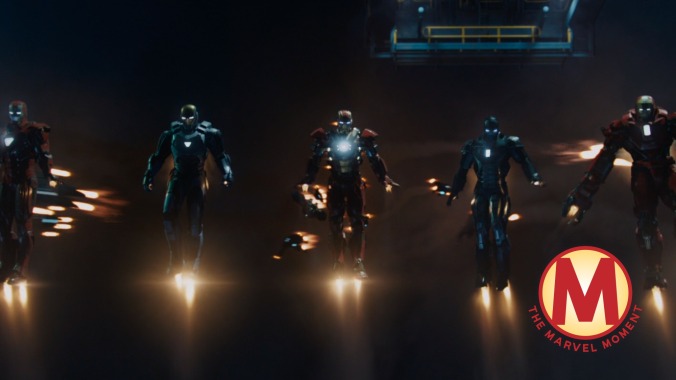Iron Man 3 blew up Tony’s suits, but can any big change really take in this mega franchise?


Shane Black’s Iron Man 3 felt like a fitting cap on the trilogy of superhero movies starring Robert Downey Jr. as a guy slowly learning how to be a hero. Whether you think the film totally works, or you appreciate Black’s attempt at smuggling in an ersatz Lethal Weapon movie (the second act, in particular, gets extremely Riggs-and-Murtaugh during Tony Stark and James “Rhodey” Rhodes’ invasion of the Mandarin’s compound), the conclusion makes sense as a logical end point for the story of Stark, a man who went from caring only about himself to blowing up all his suits in a final display of commitment to his relationship, his emotional well-being, and, well, himself. Too bad the next film immediately walked it all back.
This isn’t to say the Marvel Cinematic Universe won’t let its characters evolve. Tony Stark, in particular, has the most transformative evolution in character across the entire three-phase map of the MCU’s first decade. By the start of Iron Man 3, Stark is dealing with PTSD, the result of his near-death experience saving the world in The Avengers. He suffers panic attacks at the mere mention of the events in New York, but thanks to the attack by the Mandarin, which strips him of essentially everything but his wits, Tony learns to stop needing the protective shell of his suits, which have become a high-powered symbol of his insecurities. So in the final battle against Aldrich Killian (Guy Pearce), Tony engages all his suits in the struggle while also realizing he’s been using them as a crutch. Cue the “Clean Slate Protocol”: A.I. assistant J.A.R.V.I.S. triggers a self-destruct program, blowing up all of the Iron Legion, creating a lovely Christmas fireworks display, and seemingly ending the billionaire’s tenure as a metal-suit-developing crimefighter.
Which is why it’s disappointing to see Avengers: Age Of Ultron more or less ignore that development. When it begins, we have a new Tony psychologically, but the destruction of the suits may as well have never happened, for all the impact it seems to have had on Stark’s participation with the Avengers. There may have been an interim period in which Steve Rogers had to convince Tony to rejoin the team, rebuild some suits, and fire up the Avengers initiative full-time, but you wouldn’t know it as far as the narrative is concerned. This highlights a larger difficulty with the MCU and the juggling act it must perform when it comes to servicing the mammoth-sized team-up films in between installments of each hero’s individual franchise. The superhero sequels need things to progress and evolve, but not so much that characters can’t be easily reasserted into the middle of the next Earth-threatening disaster.
So huge developments will be walked back, or dismissed with a glib one-liner or wave of the hand in the next film, to prevent anything too problematic from causing friction in another story. It’s arguably why Captain America: Civil War was basically just another Avengers movie—it helped smooth continuity between the previous films and the still-to-come Infinity War. (Although Civil War hedged its bets even within the film itself: The final voice message from Steve to Tony is basically an assurance that their falling-out isn’t such a big deal, and he’ll see him the next time the planet’s in peril.)
The suits in the final battle also serve another, nicely metaphoric purpose, too: They highlight just how wearying the big CGI-heavy final battles in so many of the MCU films really are. Whereas Iron Man 2’s conclusion ironically showcased the hollowness of these film-ending CGI slugfests by having its hero literally fight empty suits of interchangeable weaponry, Iron Man 3 shows how soulless those clashes really are, and nimbly suggests a better alternative: Blow them the hell up.
 Keep scrolling for more great stories from The A.V. Club.
Keep scrolling for more great stories from The A.V. Club.